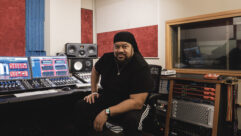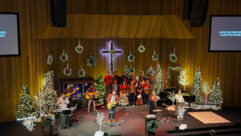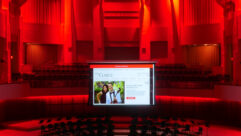Something old, something new
Mar 1, 1996 12:00 PM,
By Roger Vinton
Imagine the problems of placing a sound system in a conservatory-roofed building whose interior walls are actually the ornate stone exterior walls of adjacent buildings. Now add to that acoustic nightmare the problem of not being able to alter the acoustics of the building because of its historical importance. What you would have is Durbar Court, a glass-roofed courtyard within the old India office building in Whitehall, London, England. The building, which sits in the heart of West-minster between the Treasury building and Downing Street, was originally occupied by the British India Office. The building, now occupied by the Foreign and Commonwealth Office (F&CO), is home to administration staff, ministers and the secretary of state, whose office overlooks the Durbar Court on the east side. The Court is used for ministerial events each year, including Foreign Office banquets and other state functions.
The building, because of its age and history, is Grade-one listed, which means the building is of significant historical and architectural importance and should be maintained to its original specifications as far as is practically possible. The building is undergoing a major refurbishment program to restore the building to its former glory and provide the facilities required to run a government department.
Acoustics and aestheticsDurbar Court was originally an open courtyard between the four sides of the India office building. The court is four stories high and has a floor area of approximately 4,305 ft2 (400 m2). The pitched roof is made of glass and steel. The floor is Italian pink marble; the walls are mainly glass because they originally formed the exterior windows for the surrounding offices, which have no other means of natural light. The hard surfaces and height of the space give the Court an unoccupied reverberation time of greater than 6 seconds for frequencies less than 2 kHz.
The F&CO hired Arup Acoustics of Winchester to make an acoustic survey within Durbar Court to identify and solve the building’s problems as well as increase intelligibility for amplified speech during banquets and ministerial addressees.
Initial ideas included providing acoustic treatment for the court. However, the Arup Acoustics survey showed that installing sufficient acoustic absorptive material would prove impractical because of the historical and protected nature of the building and the dominant areas of glazing on the walls and roof. Therefore, a high-quality speech reinforcement system became the focus. Although previous functions had used temporary installations, with varying degrees of success, a permanent system was commissioned. DRV was contracted to design and install a system that would implement Arup’s recommendations.One primary factor affecting the degree of speech intelligibility within the court was the high noise generated by heating and ventilation ducts. The plant room was adjacent to the court at ground level, and ducts had virtually direct access to the court. The simplest solution was to turn off the HVAC system during speeches to increase intelligibility.
Two strikesTo see how loudspeakers would do in such a space, Arup designed a trial system, which DRV chose equipment for and installed. The system comprised a flown cluster of four d&b Audiotechiik E1 compact cabinets mounted above the head-table loudspeaker position; a single, wide-dispersion Bose 101 loudspeaker was mounted underneath the cluster for head-table foldback. Additional d&b E1 loudspeakers were located on stands in the east and west balconies to provide relay to these areas, which are used for banquet seating.
Using the E1 loudspeaker was a compromise between visual and electroacoustic preferences, although a longer column loudspeaker would offer tighter dispersion control. Although the event’s sound was satisfactory, F&CO officers decided a permanent system should be able to use a limited number of microphones located in any position within the Court.
Accordingly, a second trial was arranged. For this event, a distributed system of 12 Pro Ac tablet cabinet loudspeakers was suspended from the roof 21 feet(6.5 m) up and facing straight down toward the floor. The optimum height of 16 feet (5 m) was visually unacceptable because the loudspeakers would hang in front of the surrounding windows. Each loudspeaker was individually delayed and amplified, allowing differing room configurations with the ability to mute and attenuate appropriate loudspeakers.Although the acoustic performance for this setup was satisfactory, the F&CO considered this proposal visually unacceptable and prohibitive in cost.
Third time’s a charmA third option – a central cluster consisting of long column loudspeakers – was not tried on site, but the results were predicted via Arup Acoustics’ EASE program. This option, which specified white loudspeakers, provided a visually acceptable alternative and had a considerable cost advantage over the distributed proposals. The client chose the central cluster as the most cost-effective option that also met the aesthetic requirements of ministers and F&CO officials.
The cluster consists of six RCF CSM4/T column loudspeakers with a Bose 101 loudspeaker pointing straight down. Each loudspeaker is fed via an independent amplifier channel to allow attenuation of individual loudspeakers for different setup purposes. The cluster is mounted on a single frame and suspended on a motorized winch system, which allows the cluster to be raised up to the roof space.All amplification equipment and control equipment is located in a different part of the building; a simple control interface keeps the system from being tampered with or damaged easily when not in use. DRV proposed using an AMX control system with a touchscreen interface, which allows varying levels of operational security as well as facilities for real-time set up and the recall of preprogrammed presets.DRV chose Crest convection-cooled amps with NexSys control, which allows the amplifier control to be interfaced with the AMX control system to provide total control and recall of each operational program.Two EAW JF 50 loudspeakers mounted on custom heavyweight stands provide additional coverage for the east and west balconies. Composite outlet boxes on each balcony contain the loudspeaker outlets and the balcony microphone inlets.
The AMX control system provides gain adjustment for the microphone channels and set-up control, as well as winch control for the loudspeaker cluster and remote control for the tape deck in the equipment rack on the forth floor.
Control for the system, consisting of an AMX touchscreen and eight AMX MSP 8 panels, is located in a custom-built mahogany lectern on the ground floor adjacent to the court. Four custom, low-profile, multicore boxes for use under banquet tables are connected to the system via a hidden multipin socket located adjacent to each of the entrance steps. The system has 16 microphone inputs on the floor of the Court and two microphone inputs on the east and west balconies for a total of 20 microphone inputs.The microphone inputs and tape-recorder outputs are connected to the system mixer via an Autopatch matrix that controls the system set-up. The AMX touchscreen allows individual microphone channels to be selected pictorially via a plan of the court or through predetermined system set-ups loaded into the system memory. The presets also provide predetermined loudspeaker gain settings for individual loudspeakers to optimize the system performance.
Microphone levels are increased to line level before the matrix via Biamp eight-channel microphone pre-amplifiers mounted in the equipment rack. Transformer-isolated splits in the base of the lectern provide isolated splits of the eight selected microphone channels.
As an added safety measure, a modem allows us to monitor and control the system set up and operation from the DRV offices via the Crest NexSys and AMX control. The control system provides a simple method of replicating system performance while allowing F&CO personnel with limited technical knowledge to use the system.
The sound system has been used for a number of functions, and previous intelligibility problems are no longer present. Although this would be an accomplishment in any venue, this acheivement is even sweeter at Durbar Court because of the venue’s limitations. This improvement was achieved within the acoustic confines of the building and meets the stringent aesthetic requirements of the F&CO staff and the requirements of a Grade-one listed building.










